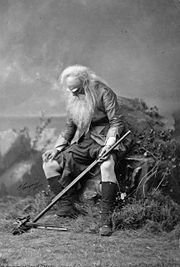I suggest we have to go back to the heliacal positions of the leading stars around 4500 B.C. in order to understand what this is all about. When the Centaur was killing the Old Beast with his spear the heliacal time was midsummer (in the northern hemisphere):
The reason for Toliman appearing a day before Yang Mun (if that indeed was the case also in ancient times) surely could be explained by pointing out that only by having the Wolf right in front could his 'lance' (rays from the Sun) work properly, killing the dark hairy creature. The Grey Wolf was not playing the role of the first half of the Sun year, instead he was the personification of the whole Old Year. A newborn infant has not much hair, but a very old man is not much else than a lazy heap of disorderly grey hairs:
... The story of Rip Van Winkle is set in the years before and after the American Revolutionary War. Rip Van Winkle, a villager of Dutch descent, lives in a nice village at the foot of New York's Catskill Mountains. An amiable man whose home and farm suffer from his lazy neglect, he is loved by all but his wife. One autumn day he escapes his nagging wife by wandering up the mountains. After encountering strangely dressed men, rumored to be the ghosts of Henry Hudson's crew, who are playing nine-pins, and after drinking some of their liquor, he settles down under a shady tree and falls asleep. He wakes up twenty years later and returns to his village. He finds out that his wife is dead and his close friends have died in a war or gone somewhere else. He immediately gets into trouble when he hails himself a loyal subject of King George III, not knowing that in the meantime the American Revolution has taken place. An old local recognizes him, however, and Rip's now grown daughter eventually puts him up ... According to the stars the new year began at midsummer and today this position must have moved forward to around autumn equinox. On Easter Island the new year could have begun around spring equinox. | |||||||||||||||||||||||
